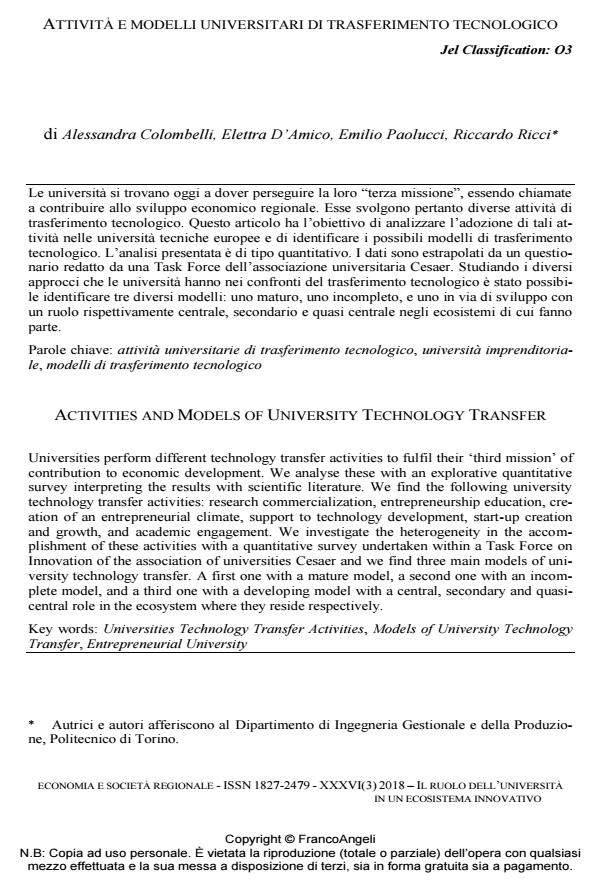Attività e modelli universitari di trasferimento tecnologico
Titolo Rivista ECONOMIA E SOCIETÀ REGIONALE
Autori/Curatori Alessandra Colombelli, Elettra D’Amico, Emilio Paolucci, Riccardo Ricci
Anno di pubblicazione 2018 Fascicolo 2018/3
Lingua Italiano Numero pagine 18 P. 10-27 Dimensione file 409 KB
DOI 10.3280/ES2018-003002
Il DOI è il codice a barre della proprietà intellettuale: per saperne di più
clicca qui
Qui sotto puoi vedere in anteprima la prima pagina di questo articolo.
Se questo articolo ti interessa, lo puoi acquistare (e scaricare in formato pdf) seguendo le facili indicazioni per acquistare il download credit. Acquista Download Credits per scaricare questo Articolo in formato PDF

FrancoAngeli è membro della Publishers International Linking Association, Inc (PILA)associazione indipendente e non profit per facilitare (attraverso i servizi tecnologici implementati da CrossRef.org) l’accesso degli studiosi ai contenuti digitali nelle pubblicazioni professionali e scientifiche
Le università si trovano oggi a dover perseguire la loro "terza missione", essendo chiamate a contribuire allo sviluppo economico regionale. Esse svolgono pertanto diverse attività di trasferimento tecnologico. Questo articolo ha l’obiettivo di analizzare l’adozione di tali attività nelle università tecniche europee e di identificare i possibili modelli di trasferimento tecnologico. L’analisi presentata è di tipo quantitativo. I dati sono estrapolati da un questionario redatto da una Task Force dell’associazione universitaria Cesaer. Studiando i diversi approcci che le università hanno nei confronti del trasferimento tecnologico è stato possibile identificare tre diversi modelli: uno maturo, uno incompleto, e uno in via di sviluppo con un ruolo rispettivamente centrale, secondario e quasi centrale negli ecosistemi di cui fanno parte.
Parole chiave:Attività universitarie di trasferimento tecnologico, università imprenditoriale, modelli di trasferimento tecnologico
- Alexander A.T., Martin D.P. (2013). Intermediaries for open innovation: A competence-based comparison of knowledge transfer offices practices. Technological Forecasting and Social Change, 80(1): 38-49.
- Amezcua A.S., Grimes M.G., Bradley S.W., Wiklund J. (2013). Organizational sponsorship and founding environments: a contingency view on the survival of business-incubated firms, 1994-2007. Academy of Management Journal, 56(6): 1628-1654.
- Autio E., Kenneth M., Mustar, P., Siegel D., Wright M. (2014). Entrepreneurial innovation: The importance of context. Research Policy, 43(7): 1097-1108.
- Becattini G. (1990). The Marshallian district as a socio-economic notion.
- In: Pyke F., Becattini G., Sengenberger W., eds. Industrial Districts and Inter-Firm Cooperation in Italy. Geneva: International Institute for Labor Studies.
- Bozeman B. (2000). Technology transfer and public policy: a review of research and theory. Research Policy, 29(4): 627-655. DOI: 10.1016/S0048-7333(99)00093-1
- Bradley S.R., Hayter C.S., Link A.N. (2013a). Models and methods of university technology transfer. Foundations and Trends in Entrepreneurship, 9(6): 571-650. DOI: 10.1007/978-1-4419-1191-9_11
- Bradley S.R., Hayter C.S., Link A.N. (2013b). Proof of concept centers in the United States: An exploratory look. The Journal of Technology Transfer, 38(4): 349-381.
- Cesaroni F., Piccaluga A. (2016). The activities of university knowledge transfer offices: towards the third mission in Italy. The Journal of Technology Transfer, 41(4): 753-777.
- Cooke P. (1997). Regions in a global market: the experiences of Wales and Baden-Wurttemberg. Review of International Political Economy, 4(2): 349-381. DOI: 10.1080/096922997347814
- D’Este P., Patel P. (2007). University-industry linkages in the UK: What are the factors underlying the variety of interactions with industry. Research Policy, 36(9): 1295-1313.
- Etzkowitz H., Leydesdorff L. (2000). The dynamics of innovation: from National Systems and ‘Mode 2’ to a Triple Helix of university-industrygovernment relations. Research Policy, 29(2):109-123.
- 10.1016/S0048-7333(99)00055-4. Etzkowitz H., Webster A., Gebhardt C., Terra B.R.C. (2000). The future of the university and the university of the future: evolution of ivory tower to entrepreneurial paradigm. Research Policy, 29(2): 313-330.
- Geuna A., Muscio A. (2009). The Governance of University Knowledge Transfer: A Critical Review of the Literature. Minerva, 47(1): 93-114.
- Grimpe C., Hussinger K. (2008). Formal and Informal Technology Transfer from Academia to Industry: Complementarity Effects and Innovation Performance. ZEW Discussion Papers. DOI: 10.1007/978-3-642-36708-3
- Hayter C.S., Link A.N. (2015). On the economic impact of university proof of concept centers. The Journal of Technology Transfer, 40(1): 178-183. DOI: 10.1177/1476127016680564
- Isenberg D.J. (2010). How to start an entrepreneurial revolution. Harvard Business Review, 88(6): 40-50. DOI: 10.2307/256548
- Jensen R., Thursby M. (2001). Proofs and prototypes for sale: The licensing of university inventions. American Economic Review, 91(1): 240-259.
- Klein K.J., Sorra J.S. (1996). The challenge of innovation implementation. Academy of Management Review, 21(4): 1055-1080. DOI: 10.2753/MIS0742-1222240103
- Kuratko D.F. (2005). The emergence of entrepreneurship education: Development, trends, and challenges. Entrepreneurship Theory and Practice, 29(5): 577-598.
- Link A.N., Siegel D.S., Bozeman B. (2007). An empirical analysis of the propensity of academics to engage in informal university technology transfer. Industrial and Corporate Change, 16(4): 641-655.
- Maia C., Claro J. (2013). The role of a Proof of Concept Center in a university ecosystem: an exploratory study. The Journal of Technology Transfer, 38(5): 641-650.
- Markman G.D., Siegel D.S., Wright M. (2008). Research and technology commercialization. Journal of Management Studies, 45(8): 1401-1423.
- O’Connor A. (2013). A conceptual framework for entrepreneurship education policy: Meeting government and economic purposes. Journal of Business Venturing, 28(4): 546-563.
- Perkmann M., Tartari, V., McKelvey M., Autio E., Broström A., D’Este P., Fini R. (2013). Academic engagement and commercialisation: A review of the literature on university-industry relations. Research Policy, 42(2): 423-442.
- Philpott K., Dooley L., O’Reilly C., Lupton G. (2011). The entrepreneurial university: Examining the underlying academic tensions. Technovation, 31(4): 161-170. DOI: 10.1016/S2212-5671(16)00051-4
- Porter M. (1998). On competition. Boston: Harvard Business School Press.
- Rauch A., Hulsink W. (2015). Putting entrepreneurship education where the intention to act lies: An investigation into the impact of entrepreneurship education on entrepreneurial behaviour. Academy of Management Learning & Education, 14(2):187-204.
- Siegel D.S., Wright M. (2015). Academic entrepreneurship: time for a rethink. British Journal of Management, 26(4): 582-595. DOI: 10.1111/1467-8551.12116
- Singh J.V., Tucker D.J., House R.J. (1986). Organizational legitimacy and the liability of newness. Administrative Science Quarterly, 31(2): 171-193. DOI: 10.2307/2392787
Alessandra Colombelli, Elettra D’Amico, Emilio Paolucci, Riccardo Ricci, Attività e modelli universitari di trasferimento tecnologico in "ECONOMIA E SOCIETÀ REGIONALE " 3/2018, pp 10-27, DOI: 10.3280/ES2018-003002